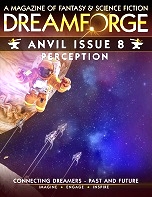 DreamForge Anvil #8, Summer 2022
DreamForge Anvil #8, Summer 2022
“The Witch’s Oath” by Karl Dandenell
“Don’t Trust Molters” by R.J.K. Lee
“Cities of Grand Illusion” by Wendy Nikel
“Your Future, Should You Choose to Accept It” by Kurt Pankau
“Light Winds with a Chance of Velociraptors” by Michelle Ann King (reprint, not reviewed)
“The Integral of My Life Over All My Choices” by Peter S. Drang
“Threshold” by Mara Buck
“What Tomorrow Has to Say” by Scott Edelman
Reviewed by Victoria Silverwolf
In addition to fiction, this issue features a poem, advice on writing, and an article about the winners of the latest Writers of the Future contest.
“The Witch’s Oath” by Karl Dandenell is a very short tale about a boy who wants to become a witch, which is impossible for males. This tiny fantasy appears to be intended as an allegory for accepting transgendered individuals for who they are. The brief length and light tone make for easy, pleasant reading, but the work is hardly a profound look at the theme.
In “Don’t Trust Molters” by R.J.K. Lee, the leader of a human colony on an alien planet discovers the blood-covered body of one of his people. He blames the local inhabitants for murder, but the truth turns out to be much different.
The plot depends on the protagonist knowing nothing about a joint project between the humans and the aliens, which seems very unlikely. The story seems to be a plea for understanding between different cultures. Although this is certainly a worthy theme, the author’s old-fashioned, slightly amateurish style fails to convey it strongly.
“Cities of Grand Illusion” by Wendy Nikel features two young women, both from the same lower-class background, who have the ability to create works of art with sensory illusions. (The story takes place in a version of the modern world where this is not uncommon.) One can create scents, but her talent is only used to produce wall coverings for bathrooms, to cover up odors. She has to support herself with a low-paying job. The other has much more highly developed skills, and becomes a wealthy, celebrated artist. At a gallery displaying the latter’s work, they learn that their friendship remains strong despite the difference in their levels of success.
The premise is a unique, striking one, and the author describes it with vivid detail. The two main characters are fully developed, believable young adults. The story effectively conveys the fact that friends can remain loyal to each other, even if their lives take very different paths.
“Your Future, Should You Decide to Accept It” by Kurt Pankau is less than two pages in length. Cassandra, the woman from Greek myth who was able to foresee the future but cursed to never be believed, advises a modern listener to make a second attempt at achieving an ambition. This brief work is mostly an inspirational essay about not giving up on one’s dreams. The fantasy aspect adds interest, but is not necessary.
The narrator of “The Integral of My Life Over All My Choices” by Peter S. Drang is a girl who has just graduated from high school, and who is about to enter a prestigious university with a full scholarship. She agrees to meet a boy late at night in a bad part of town. An older version of herself from one of many possible futures appears, warning her of the danger facing her, and the heavy price she must pay to avoid it.
The most notable aspect of this story is the fact that the author perfectly captures the narrative style of a modern teenager. This makes the speculative content of the plot seem very real. The familiar themes of time travel and parallel universes are used in a way that make them seem new. The story’s bittersweet conclusion, blending tragedy with the possibility that it can be undone, has a powerful effect on the reader.
In “Threshold” by Mara Buck, a painter enters an abandoned house. Inside she discovers magnificent works of art, as well as a ghostly voice. Further exploration reveals more about the former inhabitants, and leads to a mysterious transformation.
This brief synopsis fails to capture the author’s style, which is the most important part of this ghost story. The narrative is full of long, flowing sentences, and there is a very heavy use of metaphors. In this manner, it creates a slow, languid, subtly eerie mood. Some readers are likely to find the story overwritten in places. The plot suggests a fable about a woman having to choose between love and a career, but this is not overt.
“What Tomorrow Has to Say” by Scott Edelman features a married couple whose young child has died. The father receives telephone calls from deceased relatives, offering him advice on how to deal with his grief. A final supernatural message offers a touch of hope.
The theme of phone calls from the dead is not a new one, although the story’s climax provides an unusual variation. The plot has strong emotional appeal. Almost inevitably, however, it walks a very thin line between sincerity and sentimentality, and readers may differ on whether it avoids going over the border between the two.
Victoria Silverwolf is not a modern teenager.